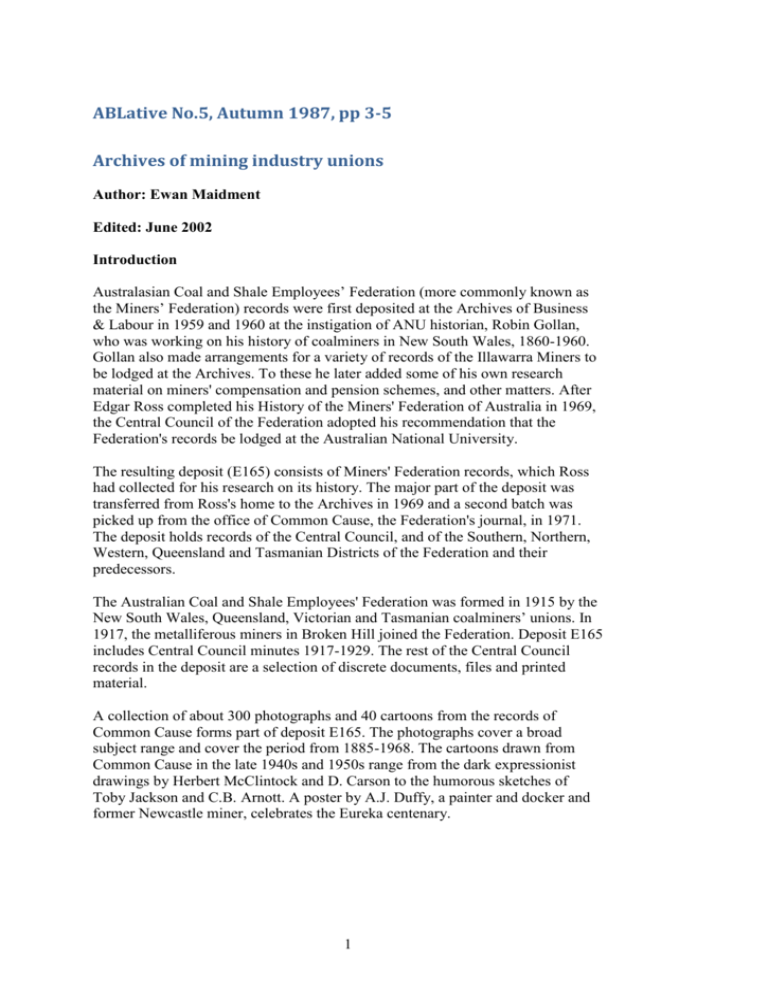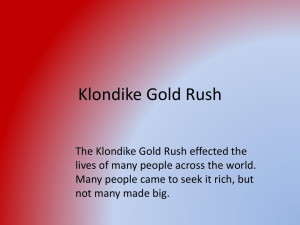Archives of Mining Industry Unions
advertisement

ABLative No.5, Autumn 1987, pp 3-5 Archives of mining industry unions Author: Ewan Maidment Edited: June 2002 Introduction Australasian Coal and Shale Employees’ Federation (more commonly known as the Miners’ Federation) records were first deposited at the Archives of Business & Labour in 1959 and 1960 at the instigation of ANU historian, Robin Gollan, who was working on his history of coalminers in New South Wales, 1860-1960. Gollan also made arrangements for a variety of records of the Illawarra Miners to be lodged at the Archives. To these he later added some of his own research material on miners' compensation and pension schemes, and other matters. After Edgar Ross completed his History of the Miners' Federation of Australia in 1969, the Central Council of the Federation adopted his recommendation that the Federation's records be lodged at the Australian National University. The resulting deposit (E165) consists of Miners' Federation records, which Ross had collected for his research on its history. The major part of the deposit was transferred from Ross's home to the Archives in 1969 and a second batch was picked up from the office of Common Cause, the Federation's journal, in 1971. The deposit holds records of the Central Council, and of the Southern, Northern, Western, Queensland and Tasmanian Districts of the Federation and their predecessors. The Australian Coal and Shale Employees' Federation was formed in 1915 by the New South Wales, Queensland, Victorian and Tasmanian coalminers’ unions. In 1917, the metalliferous miners in Broken Hill joined the Federation. Deposit E165 includes Central Council minutes 1917-1929. The rest of the Central Council records in the deposit are a selection of discrete documents, files and printed material. A collection of about 300 photographs and 40 cartoons from the records of Common Cause forms part of deposit E165. The photographs cover a broad subject range and cover the period from 1885-1968. The cartoons drawn from Common Cause in the late 1940s and 1950s range from the dark expressionist drawings by Herbert McClintock and D. Carson to the humorous sketches of Toby Jackson and C.B. Arnott. A poster by A.J. Duffy, a painter and docker and former Newcastle miner, celebrates the Eureka centenary. 1 The records New South Wales The Western District records include minutes of the Lithgow Miners' Mutual Protective Association, originally formed as the Lily of the Vale Lodge in 1878 by miners of the Vale of Clywdd Colliery, dissolved in 1881 and reorganised in 1886. Intermittent minutes of several other Western District lodges are also held. Only loose copies of the minutes of the Western Delegates' Board 1906-1907, 1927-34, are held, together with minute books of the Delegate Board of Management, 1944-1947. The only substantial records of the Northern District held by the Archives are a series of massive volumes of cuttings from the Newcastle Morning Herald, 1893-98, 1903-13. A copy of A. McLagan's seminal history of the Northern District is also held. Miners' Federation records held at the Archives of Business & Labour should be used in conjunction with Branch and Lodge records in regional Archives. Northern Lodge records are held at the University of Newcastle Archives, and one minute book (1914-1923) of the Northern District Branch is held at the Newcastle Region Public Library. Illawarra Miners' records at the Archives of Business & Labour complement Southern District Branch Minutes and correspondence, as well as extensive records of Southern Lodges, held at the University of Wollongong Archives. The Archives of Business & Labour does not hold records of the earliest south coast miners' union. Ross refers to a "useful diary" left by J. Wynn, who was a "driving force" in the formation of the Illawarra Miners' Mutual Protective Association in 1878/79, but he did not deposit it. The Illawarra Association was dissolved in 1887 and re-formed a year later as the Illawarra Colliery Employees' Association. In June 1890 it affiliated with the Amalgamated Miners' Association, along with the Newcastle and Lithgow unions, becoming the Illawarra Branch, No.2 Colonial District of the Amalgamated Miners' Association. The link with the Amalgamated Miners Association appears to have broken in 1895 and in July the Illawarra Association affiliated with the Australian Labor Federation. The Illawarra miners' records reflect the union's affiliations in items such as the minute book of the Illawarra Council of the Australian Labor Federation, 18981904. This deposit (T3) includes minutes, financial and membership records 1890-1914, and letter-books 1896-1907. An unusual record type is the series of miners' earning books which give daily tallies of individuals and overall pit production and payments in several south coast collieries 1902-29. Minutes of the Balmain (1904-11), Mt. Pleasant (1902-23) and Coledale (1922-27) Lodges are also held with the Southern District Archives. Queensland The records of the Queensland District consist of minutes of general and Committee of Management meetings of the West Moreton Coal Miners' Union (later the Queensland Colliery Employees' Union) from its formation on the Ipswich coalfields in 1896-1940. Minutes of the Trip Committees of the 2 Queensland Colliery Employees' Union 1907-1920 document arrangements made for the Union's annual day-trip by train from Ipswich to Sandgate, accompanied by a brass band, and with the prospect of sports, a banquet and dancing at the seaside. Tasmania The Tasmanian records include minutes of the Tasmanian Coal Miners' Association from its formation at Cullenswood by the Mt. Nicholas and Cornwall coal miners in 1913 to 1926. Some correspondence of the Branch and copies of its statistical returns for the same period have also survived. Victoria Minutes of the Victorian and Tasmanian District Committee, 1913-31, are held in the records of the Powlett River (Wonthaggi Branch) of the Federation collected on Edgar Ross's advice when the Branch office was closed in 1971. The deposit (E164) also includes minutes of branch general and committee meetings 1911-48 and of meetings of Combined Unions of Carpenters, Engineers, Engine Drivers and Miners 1917-48 (with gaps). Peripheral records include correspondence with the State Coal Mine 1914-60, record books of complaints, check-inspectors' reports and reports on the management of the State Coal Mine. There is also a large series of files of awards, agreements, transcripts, evidence and correspondence associated with industrial campaigns and arbitration cases involving the Powlett River (Wonthaggi) Branch, 1910-64. Further records of the Branch have been deposited at the University of Melbourne Archives. Other mining unions Other unions dealing with coal mining are the Deputies' and Shotfirers' Association, the United Collieries Staff Association, and the Federated Mining Mechanics' Association of Australasia. Of these, the Archives of Business & Labour holds records of the Deputies' and Shotfirers' Association formed in Newcastle and the Illawarra districts in 1908. We have no federal records of the Amalgamated Miners' Association or its successor, the Federated Mining Employees' Association. Records of the Barrier Branch of the Amalgamated Miners' Association, 1889-1917, are held in the offices of Workers' Industrial Union of Australia. Archives of the Australian Workers Union at the Archives of Business & Labour contain some Amalgamated Miners’ Association records. A printed copy of the Minutes of the 1913 annual conference of the New South Wales Branch of the Amalgamated Miners’ Association can to be found in the Miners' Federation records (E165/3/1). 3 Early reference to the Amalgamated Miners’ Association and the Amalgamated Mining Engine Drivers' Association are held in the Archives of the Ballarat Trades and Labour Council at the Archives of Business & Labour. Delegates of both unions were active in the formation and operation of the Council and its predecessors 1882-90. A complete set of minutes document their activities. Some correspondence also survives. Although mainly dealing with administrative matters, one letter from W.G. Spence in March 1890 touches on the Amalgamated Miners’ Association withdrawal of support for the Council and subsequent disaffiliation, possibly over differing attitudes to the Australian Labor Federation. The Australian Workers' Union gained coverage of most metalliferous miners in 1915. The Union has a considerable number of members engaged in rock mining and upgrading processes at Mt. Isa, Mt. Newman, Hammersley, Mt. Goldsworthy and Woodlawn. Australian Workers' Union records are held at the Archives of Business & Labour and are available to researchers who have been given clearance by the Union. The Federated Engine Drivers' and Firemen's Association covers drivers of stationary engines and earth moving plant, such as bulldozers and draglines, in both coal and metalliferous mining. Comprehensive records of the Federal Office and the New South Wales Coast District Branch have been lodged at the Archives of Business & Labour, including federal minutes from 1916 and New South Wales State Council and Executive Minutes, 1915-27 and 1938-80. Records of the Newcastle, Maitland and Illawarra Sub-Branches are also held. Detailed industrial files in the Federal and Coast District deposits document the involvement of the union in rock mining at Mt. Lyell, King Island, Tennant Creek, Cobar and elsewhere, and in coal mining in New South Wales and Queensland from 1910 to the present. No records of the Barrier Branch of Federated Engine Drivers' and Firemen's Association (which dates from the late 1880s) have been lodged at the Archives, nor have those of the Newcastle Colliery Engine Drivers Union (formed 1889, amalgamated with the Federated Engine Drivers' and Firemen's Association in 1921). Records of the Queensland Branch are at the Fryer Library, University of Queensland. 4




